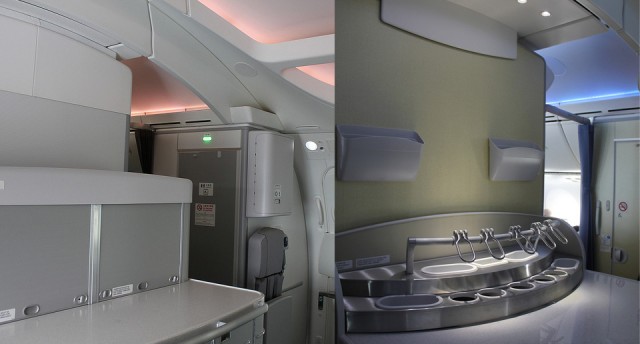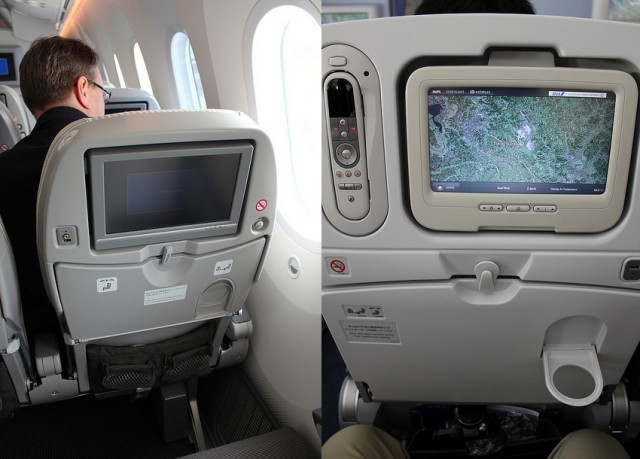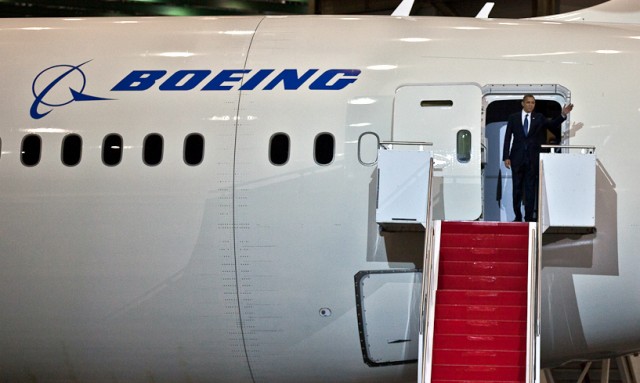
Let's get ready to rumble! Whose 787 is better? JAL's or ANA's?
What’s better than one Dreamliner? Two of course. I have been lucky enough to be on 787 Dreamliners for two different airlines: All Nippon Airlines (ANA) and Japan Airlines (JAL). I have had many people ask me how they were different and figured the answer was good enough for a blog write up.
Now, before I move forward, I want to put a few things out there. First, I have been on ANA’s 787s multiple times and was even able to fly on one. I have only been on JAL’s for a short time while on the ground. The biggest difficulty to compare is that ANA’s Dreamers were set up in a domestic configuration, whereas JAL’s was in an international. Because of this I do not feel it fair to compare everything (like business class seats), but I think there is enough to compare and contrast in this friendly competition.
I have broken down each 787 into different categories and awarded a winner in each:

JAL recently came out with a new livery, but there is nothing special on the livery for their first 787 like ANA had.
Delivery Livery: ANA
ANA went all out for their first two Boeing 787s with a special livery. The large “787” makes it clear that this is a Dreamliner, even to those non AvGeeks. Even though JAL’s new livery is starting to grow on me, it just can’t complete.

JAL's entry way is on the left and ANA's is on the right to its 787s.
Entrance Bar: ANA
When first walking into the 787 there is a large entry way that can be set up as a bar during flight. Although both were impressive, I think that ANA having the wine holders out in the open really made it win this one.

Even though my favorite color is blue, overall, I like the atmosphere of JAL's 787 cabin (on the left) versus ANA's.
Overall Cabin Atmosphere: JAL
I really cannot put my finger on it, but JAL’s cabin overall just felt better. This is not to say that ANA’s felt bad, but I think maybe the fact that the economy seats have a lined fabric and the soothing colors just made me feel more comfortable in the JAL 787 versus the ANA. Although, someone else who was at the JAL 787 delivery, who also had been on ANA’s aircraft commented that he liked ANA’s interior atmosphere better.

JAL's lavatories aren't bad (on the left), but you can't beat a lavatory with a window in it that ANA has.
Lavatory: ANA
Both airlines offer nifty features in their lavatories, but this one went to ANA for choosing to put a window in one of their lavatories. The window actually provides some pretty amazing views of the 787 wing while in-flight and has the only sunshade in the cabin.

JAL (left) went for more width on each economy seat, where ANA (right) gave more arm room for the folks stuck in the middle.
Economy Class Width: Both
This one is really about where you sit. Even though the 787 Dreamliner can be configured with nine seats across, both JAL and ANA went with eight. Where ANA put in a double arm-rest into the very middle of the cabin, JAL went with a single armrest in the middle, but spread the width to all the seats. If I were sitting in a middle seat, then ANA wins, but if I am sitting anywhere else, JAL is the winner.

What is more important? Having a larger screen on JAL's 787 (left) or the remote in the seat-back on ANA's (right)?
In Flight Entertainment Screen: JAL
This is literally for the screen and seat-back only. I was able to spend a few minutes on the ANA 787 to play with the system, but really was not enough time to make any conclusions. I was not able to play with JAL’s.
Just looking at the larger and cleaner looking screen in the JAL 787 wins this one. Although ANA’s screen is a bit smaller, I really like the fact that the remote is in the seat versus in the armrest.

Can you tell which one is which? The one of the left is JAL's and the one on the right is ANA's.
Flight Deck: Both
This almost reminds me of Highlights magazine when I was a child and had two photos and had to try to find the differences. Look hard, there are not going to be too many. The 787 cockpit is a beautiful work of engineering and both of them win.
Conclusion
So if I had to pick only one 787 Dreamliner to fly on right now, which one would it be? Ha! That is like asking which child is your favorite. JAL, ANA and Boeing have done a great job with the new interiors and passengers will enjoy flying on either.
Those who are loyal to either JAL or ANA are probably not going to be swayed to change airlines based on differences in their 787 configurations.

The enterance to the Boeing Flight Services in Seattle, WA. Photo by Jeremy Dwyer-Lindgren / NYCAviation.com
Boeing Flight Services (BFS) offers eight locations around the world that provides pilot, maintenance, composite and cabin crew training. Around the world, Boeing offers 80 flight simulators (eight are for the 787). The locations for the 787 training facilities are located in London, Singapore, Shanghai, Tokyo and of course Seattle. We recently had the opportunity to take a behind the scenes look at the pilot training part of the BFS facility located south of Seattle,WA.
Currently, Boeing has orders for 873 787 Dreamliners. For each new aircraft that gets delivered, there need to be pilots, technicians and flight crew that require training. Boeing works with their airline customers to provide a customized training package. They can choose to have their entire staff trained, or just a handful of trainers who return to the carrier armed with all the knowledge they need.

The room we were in had four simulators. Two for the 787, one for the 737 and one for the 767. Notice how they are painted in different Boeing liveries. Photo by David Parker Brown / AirlineReporter.com
How long it takes for a new pilot to be trained on the 787 depends on their previous experience. Since the 777 and 787 cockpits are so similar, it only takes pilots five days to be trained on the Dreamliner. A pilot who has flown other Boeing products (like the 767 or 737), it can take 13 days and if a pilot has never flown a Boeing product, it takes 20 days.
The section of the facility we visited held four simulators: two for the 787, one for the 737 and one for the 767. Before getting into full simulator, pilots will start out on a desktop simulation, which students are able to view a 3-D virtual 787 to learn about the aircraft before taking the controls.

Inside the Boeing 787 flight simulator. Photo by Jeremy Dwyer-Lindgren / NYCAviation.com.
Next, pilots move to the flight training device that looks like a desk-mounted simulator and lets the flight crew become familiar with the instruments and airplane systems better before hitting the fully operation simulator.
Before each flight in the full simulator, pilots will sit down with their Boeing instructor to go over the details and expectations of the flight. Boeing flight instructors, on average, have 15,700 total time and at minimum, they are required to have at least 5,000 hours with 1,000 of those in training.

The flight instructor's chair inside the Dreamliner flight sim. Photo by Jeremy Dwyer-Lindgren / NYCAviation.com.
Pilots normally fly for four hours in the simulator and afterwards, trainers will go step-by-step with the pilots using playback from the simulator.
When entering the simulator, the first thing that stands out is the large chair in the middle of everything. The chair appears more at home on the bridge of the Starship Enterprise than the simulator we’re standing in. The chair, affectionately called ’œCaptain Kirk’s Seat’, is where the instructor is direct and manage the simulation along with being able to see the same visualization that the pilots are.

In flight over Japan in the 787 flight simulator. Photo by Jeremy Dwyer-Lindgren / NYCAviation.com.
Due to the number of media on the tour the full motion capability was switched off, but that did not stop from making the experience enjoyable. Flight instructor Captain Greg Beard pressed a few buttons on the trainer chair and everyone was whisked away at the speed of light to Narita International Airport in Tokyo. Capt. Beard sat in the co-pilot seat as he smoothly took off the Dreamliner to take a tour around Tokyo.
Being in a few 787 cockpits (not during flight), it is easy to say that the simulator is very accurate to the actual Dreamliner. Beard confirmed this by explaining that all the same software and options on the actual aircraft are in the simulator ’“ actually there are more. The simulator can be programed to have either the GEnx engines or RR Trent 1000 (there are few differences in the flight deck of the two). The simulator can also be used for the future 787-9 model as well.

A view of the HUD (heads up display) while sitting at Seattle-Tacoma International Airport. Photo by Jeremy Dwyer-Lindgren / NYCAviation.com.
Although the Boeing 787 is a complex machine, it has been built to make flying as easy as possible. It is not cheap to purchase your own 787 simulators. They are manufactured by Thales, cost about $15-$18million each.
SEE ALL 43 PHOTOS OF THE BOEING 787 DREAMLINER FLIGHT SIMULATOR
This story was a joint effort by AirlineReporter.com and NYCAviation.com.

HI RES IMAGE (click for larger). JAL Boeing 787 Dreamliner at Paine Field. Photo by Boeing.
Japan Airlines (JAL) announced today that they plan to take official delivery of their first 787 Dreamliner this Sunday, March 25th, with a delivery ceremony to follow on the 26th. The aircraft is then scheduled to take off from Paine Field at about 4pm local time on Monday to head to Narita in Tokyo with JAL pilots at the controls.
The airline plans to start operating their first Dreamliner on their new Boston to Tokyo route, currently scheduled to start on April 22, 2012. JAL has also announced the intention of starting 787 service between San Diego and Tokyo later in the year.

HI RES IMAGE (click for larger). Executive Class cabin on JAL's first Boeing 787 Dreamliner. Photo by Boeing.
JAL becomes the second airline to take delivery of a 787, but this aircraft will represent a few firsts: It will be the first one to be delivered with GEnx engines, the first to be commercially fly a route to the US and the first to be used on a brand new route (ANA’s 787s have replaced other aircraft on routes that already existed).
The first aircraft is configured in a two class layout, with 42 seats in business class and 144 seats in economy.

HI RES IMAGE (click for larger). The economy cabin inside JAL's first Boeing 787 Dreamliner. Photo by Boeing.
The business (or executive) class seats are in a 2-2-2 layout and provide about 60″ of seat pitch and a bit over 21″ of width. The seat will recline to about 171 degrees. The Economy class is configured in a 2-4-2 layout and will provide 31″ seat pitch and 18.5″ seat width.

HI RES IMAGE (click for larger). JAL's Boeing 787 Dreamliner taking off at Paine Field. Photo by Boeing.
JAL’s new in-flight entertainment system, called SKY MANGA, will also debut on the aircraft. The interior has a very different looking atmosphere than ANA’s Dreamliner cabin.

Most people were probably distracted by President Obama, but if you look close, you can see the joint on the 787, meaning it has not been painted. Photo by Jeremy Dwyer-Lindgren / NYCAviation
Yesterday President Obama made a visit to the Boeing Factory at Paine Fieldand he was able to make a speech in front of United’s first 787 Dreamliner. The aircraft looked to be in standard United livery, making it seem that they might not be planning a special livery, but look a bit closer. You can see the joints of the plane, meaning it is not painted.

The Globe looked pretty good on this 787, but don't get attached. It is coming off -- at least for now.
The opportunity to have Obama stand in front of a 787 is something you do not want to pass up. Problem was that no 787 has been painted in an airline’s livery based in the US. No problem; you can slap some decals on the plane and make it look (on the most part) ready for service — and that is just what Boeing did.

United's "new" livery continues to grow on me and I think it will look good on the Dreamliner. Photo by Jeremy Dwyer-Lindgren / NYCAviation.
“The unfinished plane wore temporary decals showing United’s standard livery to serve as a backdrop for the event,” Mary Ryan with United communications explained to AirlineReporter.com. So now, the big question still remains: will United be painting their first 787 Dreamliner in a special livery?

Starting at about 1pm on 2/9 and ending on the morning of 2/10, Boeing 787 ZA236 created this epic design. Click for larger. Image from FlightAware.com.
The fact that Boeing just spent almost 19 hours flying one of their 787 Dreamliners around the country, creating a “787” and Boeing logo has multiple levels to it. First, it is just frek’n awesome. Even though Boeing made a “747” in the sky recently with a 747-8F and also flew over 48 states with a 747-8I, this one takes the cake. Those other two mostly required straight lines and really the “747” was a bit shaky. Not only were these 787 pilots able to successfully make a “787,” but also the full Boeing logo — what an accomplishment. Not quite sure how a pilot might put that on their resume, but I hope that they do!
Boeing’s goal for the flight was not just to make a cool design in the sky, but to also put the GEnx-1B engines to the test. From Randy Tinseth, vice president, marketing for Boeing Commercial Airplanes, stated this morning on his blog, “It was an 18 hour Maximum ETOPS (Extended Operations) Duration flight test for a 787-8 with GE engines. Our team coordinated with the many air traffic control centers, choosing the routing to avoid restricted airspace. In the end, the flight covered over 9,000 nautical miles.”

ZA236 inside the Boeing factory on 9/25/11. Photo by AirlineReporter.com
Digging a bit deeper, I think this is strong evidence to show how much Boeing has changed over the last few years. I have followed Boeing’s change from being a company that really did not reach out to fans to one that celebrates the fact that they are loved by so many. From Boeing starting and becoming successful with social media to creating a YouTube channel, they have come a long way and they keep showing their growth.
Boeing had a task to operate a 787 Dreamliner for a long test flight and they could have easily ran a big circle or up and down the coast. Instead, they decided to put in quite a few hours to plan and execute this historic sky-writing flight.
I am sure that Boeing was hoping to keep this a surprise, but I know there are many fans out there who track every movement of every Boeing 787 Dreamliner and it is hard to keep this sort of thing hidden from the internet — especially when it takes almost 19 hours to complete.
So cheers to Boeing for pulling this off and to those eagle eyes who caught it!
SEE SCREEN SHOTS OF THE DESIGN IN PROCESS






















